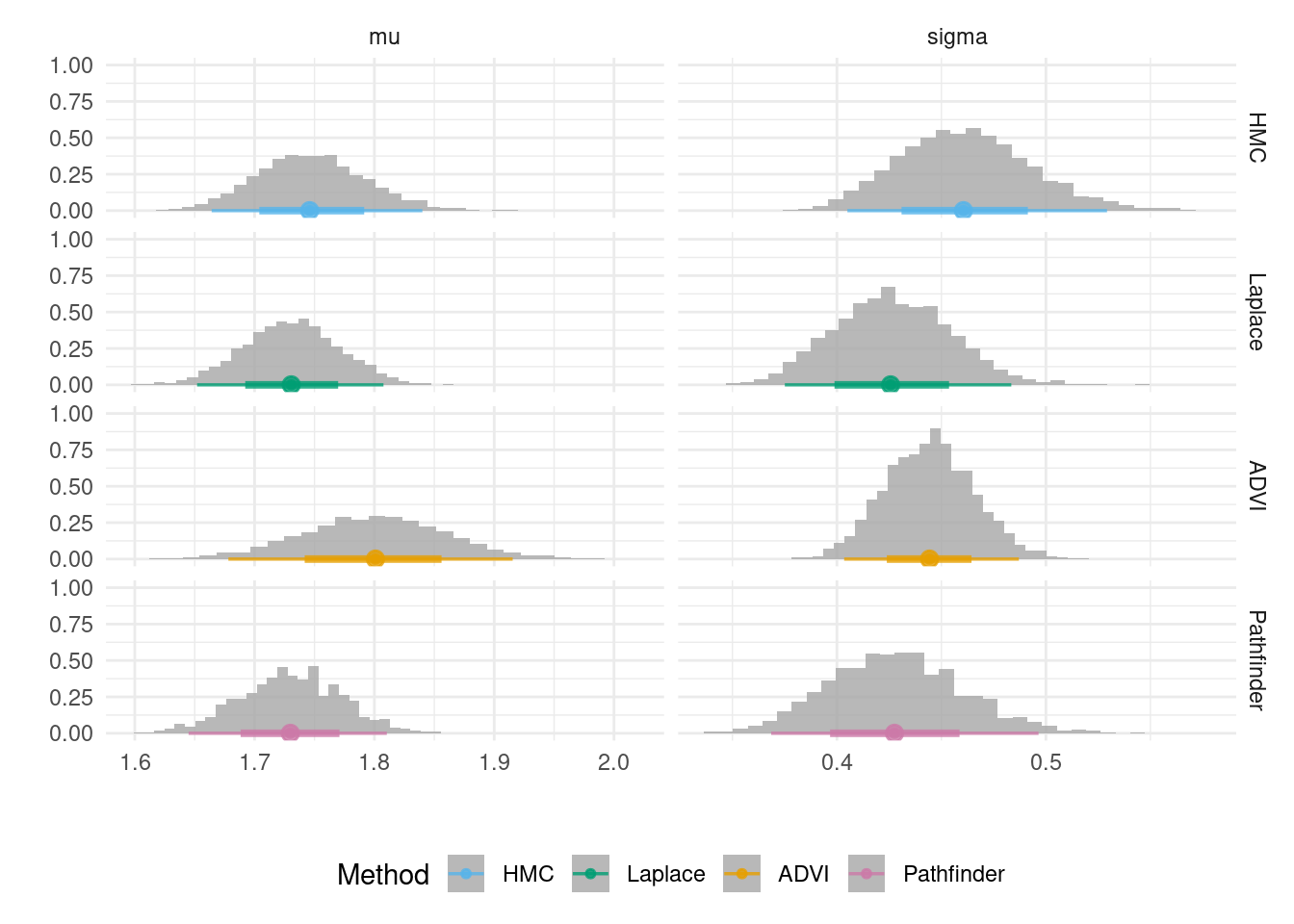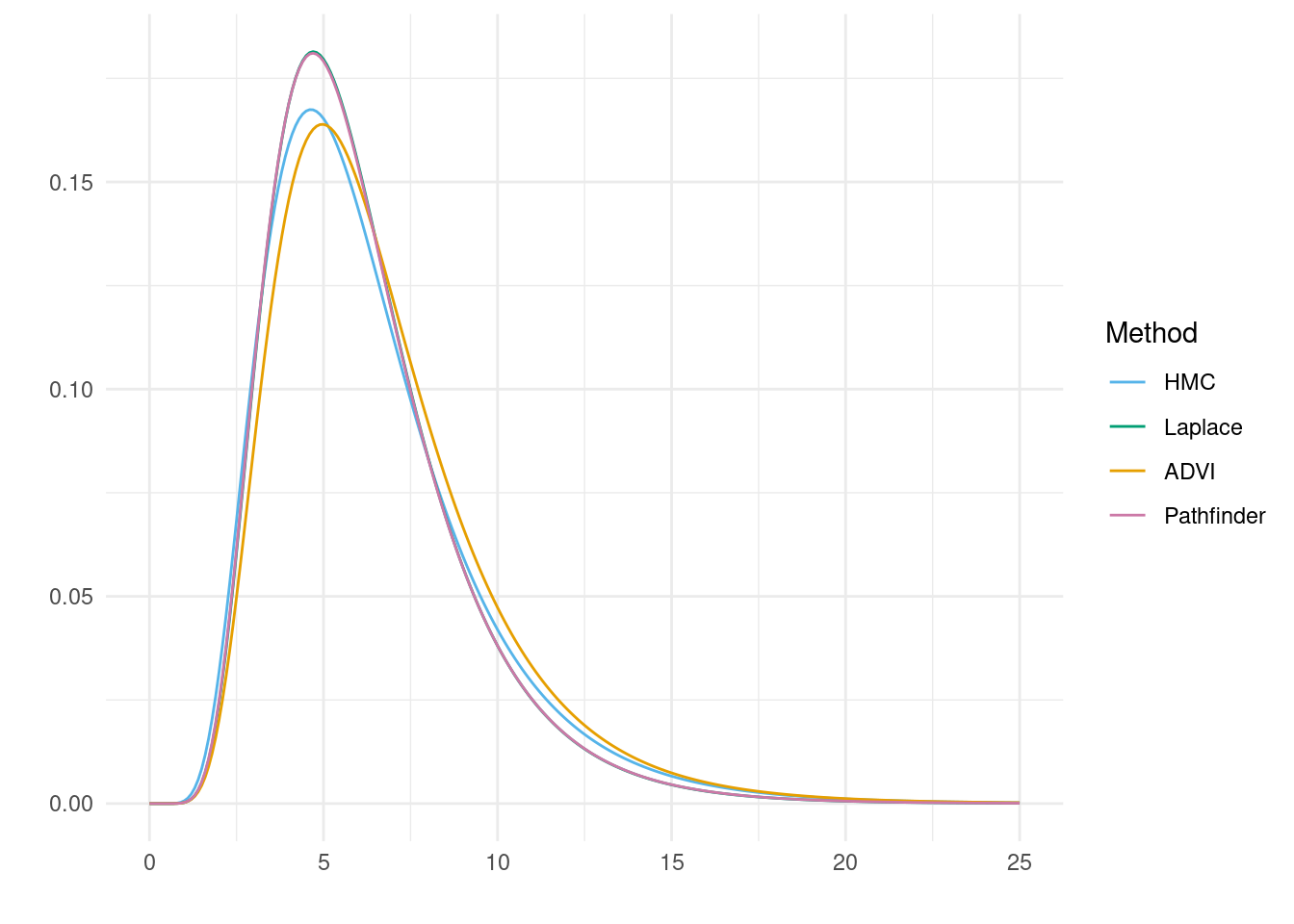
Approximate Bayesian inference in epidist
Source:vignettes/approx-inference.Rmd
approx-inference.Rmd1 Background
The epidist package uses Bayesian inference to estimate delay distributions and other quantities.
Doing Bayesian inference amounts to approximating the posterior distribution of each parameter in the statistical model1.
A range of methods exist to perform this approximation.
By default, epidist uses the No-U-Turn Sampler [NUTS; Hoffman, Gelman, et al. (2014)] Hamiltonian Monte Carlo (HMC) algorithm.
NUTS is an example of a broader class of Markov chain Monte Carlo (MCMC) methods.
These methods work by simulating from a Markov chain with the target posterior distribution as its stationary distribution.
When MCMC algorithms are run for sufficiently many iterations, and have reached convergence, the samples can be treated as being drawn from the posterior distribution.
Relevant posterior quantities such as expectations may then be computed using these samples.
A drawback of MCMC methods, like NUTS, is that simulations can be quite computational intensive, especially for complex models or large data.
The epidist package is built using brms (Bürkner 2017), which stands for “Bayesian Regression Models using Stan”, where Stan (Carpenter et al. 2017) is a probabilistic programming language.
Although NUTS is the primary inference algorithm used in Stan, additional options are available.
These additional inference algorithms are also available in epidist due to its dependence on brms.
In this vignette, we first briefly describe the alternative algorithms available (Section 2) as well as directing you to more detailed resources. Then (Section 3) we demonstrate their application to fitting simulated data, before extracting and comparing posterior distributions. By comparing the resulting inferences to those from NUTS, we hope to help you make informed decisions about which algorithm to use in your applied problem.
2 Alternative approximate inference algorithms
Here we describe three alternative approximate Bayesian inference algorithms that are available to use in brms, and therefore also available in epidist.
It’s worth noting that further inference algorithms may have become available since this vignette was last updated.
Please check brms package updates if interested!
2.1 Laplace method
The Laplace method approximates a posterior distribution by a Gaussian distribution centered (by default) at the posterior mode.
In Stan, the Gaussian approximation is constructed on the unconstrained parameter space (as the domain of a Gaussian distribution is the real line).
Samples from the Gaussian approximation may then be transformed to the constrained parameter space.
To access the Laplace method, specify algorithm = "laplace" within brms::brm().
See the section Laplace Sampling of the CmdStan User’s Guide for more information.
2.2 Variational inference using ADVI
Automatic differentiation variational inference [ADVI; Kucukelbir et al. (2017)] is a type of variational inference [VI; Blei, Kucukelbir, and McAuliffe (2017)] algorithm.
VI works by restricting to a family of distributions, and then selecting the member of that family which is the most similar to the posterior distribution.
Most commonly, and in Stan, (dis-)similarity is measured using the Kullback–Leibler (KL) divergence.
There are two options for the family of distributions, either a fully factorised Gaussian with algorithm = "meanfield" or a Gaussian with a full-rank covariance matrix with algorithm = "fullrank".
See the section Variational Inference using ADVI of the CmdStan User’s Guide for more information.
2.3 Pathfinder
Pathfinder is a method closely related to variational inference, which has been more recently developed by Zhang et al. (2022).
It works by generating Gaussian approximations along each step of an iterative optimisation algorithm (such as L-BFGS).
The KL divergence from each approximation to the posterior is measured, with the best approximation chosen.
Pareto smoothed importance sampling [PSIS; Vehtari et al. (2015)] is optionally used to resample draws from the chosen Gaussian distribution.
When multiple paths are specified (using num_paths) then the Pathfinder algorithm is run multiple times, initialising the optimisation at different points.
The resulting approximation is a mixture of Gaussian distributions, rather than a single Gaussian distribution.
See the section Pathfinder Method for Approximate Bayesian Inference of the CmdStan User’s Guide for more information.
3 Demonstration
In this demonstration, we use the following packages:
library(epidist)
library(ggplot2)
library(dplyr)
library(purrr)
library(tidyr)
library(tibble)
library(tidybayes)
library(cmdstanr) # nolintTo access the approximate inference methods used in this vignette we will need to use the cmdstanr backend for brms (we generally recommend using this backend for fitting models).
To do this, we first need to install CmdStan (see the README for more details).
We can check we have everything we need as follows:
cmdstanr::cmdstan_version()
#> [1] "2.36.0"We can simulate data to use for fitting models. The example data simulation process follows that used in the Getting started with epidist vignette, so we will not detail exactly what is happening here, but please consult that vignette if interested:
Click to expand for data simulation code
meanlog <- 1.8
sdlog <- 0.5
obs_time <- 25
sample_size <- 200
obs_cens_trunc_samp <- simulate_gillespie(seed = 101) |>
simulate_secondary(
meanlog = meanlog,
sdlog = sdlog
) |>
mutate(
ptime_lwr = floor(.data$ptime),
ptime_upr = .data$ptime_lwr + 1,
stime_lwr = floor(.data$stime),
stime_upr = .data$stime_lwr + 1,
obs_time = obs_time
) |>
filter(.data$stime_upr <= .data$obs_time) |>
slice_sample(n = sample_size, replace = FALSE)We now prepare the data for fitting with the marginal model, and perform inference with HMC:
linelist_data <- as_epidist_linelist_data(
obs_cens_trunc_samp$ptime_lwr,
obs_cens_trunc_samp$ptime_upr,
obs_cens_trunc_samp$stime_lwr,
obs_cens_trunc_samp$stime_upr,
obs_time = obs_cens_trunc_samp$obs_time
)
data <- as_epidist_marginal_model(linelist_data)
t <- proc.time()
fit_hmc <- epidist(data = data, algorithm = "sampling", backend = "cmdstanr")
time_hmc <- proc.time() - tNote that for clarity above we specify algorithm = "sampling", but if you were to call epidist(data = data) the result would be the same since "sampling" (i.e. HMC) is the default value for the algorithm argument.
Now, we fit2 the same marginal model using each method in Section 2. To match the four Markov chains of length 1000 in HMC above, we then draw 4000 samples from each approximate posterior.
t <- proc.time()
fit_laplace <- epidist(
data = data, algorithm = "laplace", draws = 4000, backend = "cmdstanr"
)
time_laplace <- proc.time() - t
t <- proc.time()
fit_advi <- epidist(
data = data, algorithm = "meanfield", draws = 4000, backend = "cmdstanr"
)
time_advi <- proc.time() - tFor the Pathfinder algorithm we will set num_paths = 1.
Although in testing both the Laplace and ADVI methods ran without problem in all cases, we found Pathfinder often produced “Error evaluating model log probability: Non-finite gradient.”.
Although a save_single_paths option is available, which may have allowed recovery of individual Pathfinder paths (and therefore removing faulty paths), it does not appear to be working currently3.
t <- proc.time()
fit_pathfinder <- epidist(
data = data, algorithm = "pathfinder", draws = 4000, num_paths = 1,
backend = "cmdstanr"
)
#> Warning: Number of PSIS draws is larger than the total number of draws returned by the single Pathfinders. This is likely unintentional and leads to re-sampling from the same draws.
#> Path [1] :Initial log joint density = -2065.792583
#> Error evaluating model log probability: Non-finite gradient.
#> Error evaluating model log probability: Non-finite gradient.
#> Error evaluating model log probability: Non-finite gradient.
#> Path [1] : Iter log prob ||dx|| ||grad|| alpha alpha0 # evals ELBO Best ELBO Notes
#> 12 -3.910e+02 1.073e-04 4.453e-03 1.000e+00 1.000e+00 301 -3.950e+02 -3.950e+02
#> Path [1] :Best Iter: [10] ELBO (-395.015688) evaluations: (301)
#> Finished in 0.2 seconds.
time_pathfinder <- proc.time() - tWe now extract posterior distribution for the delay parameters from the fitted model for each inference method. Thankfully, each algorithm is implemented to sample draws from the posterior distribution, and so post-processing is simple.
Click to expand for code to extract posterior draws
fits <- list(
HMC = fit_hmc,
Laplace = fit_laplace,
ADVI = fit_advi,
Pathfinder = fit_pathfinder
)
draws <- imap(fits, function(fit, name) {
draws <- fit |>
predict_delay_parameters() |>
as.data.frame() |>
pivot_longer(
cols = c("mu", "sigma", "mean", "sd"),
names_to = "parameter",
values_to = "value"
) |>
filter(parameter %in% c("mu", "sigma")) |>
mutate(method = as.factor(name))
return(draws)
})
draws <- bind_rows(draws)3.1 Comparison of parameter posterior distributions
The mean estimated value of each parameter, from each method is as follows.
pars <- draws |>
group_by(method, parameter) |>
summarise(value = mean(value)) |>
pivot_wider(names_from = parameter, values_from = value) |>
ungroup()
pars
#> # A tibble: 4 × 3
#> method mu sigma
#> <fct> <dbl> <dbl>
#> 1 HMC 1.75 0.461
#> 2 Laplace 1.74 0.455
#> 3 ADVI 1.77 0.513
#> 4 Pathfinder 1.74 0.456More comprehensively, the estimated posterior distributions are shown in Figure 3.1.
Click to expand for code to create posterior distribution plot
p_posterior <- draws |>
ggplot(aes(x = value, col = method)) +
stat_slabinterval(density = "histogram", breaks = 30, alpha = 0.8) +
scale_colour_manual(values = c("#56B4E9", "#009E73", "#E69F00", "#CC79A7")) +
facet_grid(method ~ parameter, scales = "free_x") +
theme_minimal() +
guides(fill = "none") +
labs(x = "", y = "", col = "Method") +
theme(legend.position = "bottom")
p_posterior
Figure 3.1: Estimated posterior distributions for the mu and sigma parameters using each inference method, shown using tidybayes::stat_slabinterval().
3.2 Comparison of resulting delay distributions
Figure 3.2 shows how the different mu and sigma posterior mean estimates from each inference method alter an estimated delay distribution.
Click to expand for code to create delay PDF plot
p_delay_pdf <- pmap_df(
filter(pars), ~ tibble(
x = seq(0, 25, by = 0.1),
method = ..1, density = dlnorm(x, ..2, ..3)
)
) |>
ggplot(aes(x = x, y = density, col = method)) +
geom_line(linewidth = 1) +
scale_color_manual(values = c("#56B4E9", "#009E73", "#E69F00", "#CC79A7")) +
theme_minimal() +
labs(x = "", y = "", col = "Method") +
theme(legend.position = "bottom")
p_delay_pdf
Figure 3.2: Delay probability density functions obtained based on the posterior mean estimated mu and sigma parameters.
3.3 Comparison of time taken
In this example, HMC took a longer time to run than the other methods and Pathfinder was the fastest running method. That said, even for HMC the computation time in this case is unlikely to be prohibitive.
times <- list(
HMC = time_hmc,
Laplace = time_laplace,
ADVI = time_advi,
Pathfinder = time_pathfinder
)
times
#> $HMC
#> user system elapsed
#> 23.532 0.993 24.000
#>
#> $Laplace
#> user system elapsed
#> 0.983 0.299 1.428
#>
#> $ADVI
#> user system elapsed
#> 1.172 0.119 1.287
#>
#> $Pathfinder
#> user system elapsed
#> 0.478 0.120 0.6814 Conclusion
The range of alternative approximation algorithms available, and their ease of use, is an attractive feature of brms.
We found that these algorithms do produce reasonable approximations in far less time than HMC.
Of course, this vignette only includes one example, and a more thorough investigation would be required to make specific recommendations.
That said, currently we do not recommend use of the Pathfinder algorithm due to its unstable performance in our testing, and early stage software implementation.